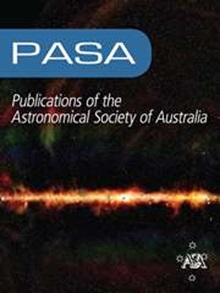M dwarfs found in the first Byurakan spectral sky survey database. Gaia EDR3 and TESS data. Some preliminary results
IF 4.6
3区 物理与天体物理
Q1 ASTRONOMY & ASTROPHYSICS
Publications of the Astronomical Society of Australia
Pub Date : 2023-04-20
DOI:10.1017/pasa.2023.20
引用次数: 1
Abstract
Abstract In order to gain more information on the 236 M dwarfs identified in the First Byurakan Survey (FBS) low-resolution (lr) spectroscopic database, Gaia EDR3 high-accuracy astrometric and photometric data and Transiting Exoplanet Survey Satellite (TESS) data are used to characterise these M dwarfs and their possible multiplicity. Among the sample of 236 relatively bright $(7.3 < K_S < 14.4)$ M dwarfs, 176 are new discoveries. The Gaia EDR3 G broadband magnitudes are in the range $11.3 < G < 17.1$ . New distance information based on the EDR3 parallaxes are used to estimate the G-band absolute magnitudes. Nine FBS M dwarfs out of 176 newly discovered lie within 25 pc of the Sun. The FBS 0909-082 is the most distant $(r=780$ pc) M dwarf of the analysed sample, with a G-band absolute magnitude $M(G) = 9.18$ , $M = 0.59$ M $_{\odot}$ , $L = 0.13597$ L $_{\odot}$ , and $T_{eff}$ = 3844 K; it can be classified as M1 - M2 subtype dwarf. The nearest is FBS 0250+167, a M7 subtype dwarf located at 3.83 pc from the Sun with a very high proper motion (5.13 arcsec yr $^{-1}$ ). The TESS estimated masses lie in the range 0.095 ( $\pm$ 0.02) M $_{\odot}\leq$ $M\leq$ 0.7 ( $\pm$ 0.1) M $_{\odot}$ and $T_{eff}$ in the range 4000 K < $T_{eff}$ < 2790 K. We analyse colour-colour and colour-absolute magnitude diagram (CaMD) diagrams for the M dwarfs. Results suggest that 27 FBS M dwarfs are double or multiple systems. The observed spectral energy distribution (SED) for some of the M dwarfs can be used to classify potential infrared excess. Using TESS light curves, flares are detected for some FBS M dwarfs. Finally, for early and late sub-classes of the M dwarfs, the detection range for survey is estimated for the first time.在第一个Byurakan光谱巡天数据库中发现的M矮星。盖亚EDR3和TESS数据。一些初步结果
摘要:为了获得更多关于第一次比拉坎巡天(FBS)低分辨率光谱数据库中发现的236颗M矮星的信息,利用盖亚EDR3高精度天体测量和光度测量数据和凌日系外行星巡天卫星(TESS)数据对这些M矮星及其可能的多样性进行了表征。在236个相对明亮的$(7.3 < K_S < 14.4)$ M矮星样本中,有176个是新发现的。盖亚edr3g宽带星等在$11.3 < G < 17.1$范围内。基于EDR3视差的新距离信息被用于估计g波段的绝对星等。在新发现的176颗FBS M矮星中,有9颗位于距离太阳25%的范围内。FBS 0909-082是分析样本中距离最远的$(r=780$ pc) M矮星,其g波段绝对星等为$M(G) = 9.18$、$M = 0.59$ M $_{\odot}$、$L = 0.13597$ L $_{\odot}$和$T_{eff}$ = 3844 K;可归类为M1 - M2型矮星。最近的是FBS 0250+167,一颗M7亚型矮星,距离太阳3.83 pc,具有非常高的固有运动(5.13弧秒/年$^{-1}$)。TESS的估计质量范围为0.095 ($\pm$ 0.02) M $_{\odot}\leq$$M\leq$ 0.7 ($\pm$ 0.1) M $_{\odot}$和$T_{eff}$,范围为4000 K < $T_{eff}$ < 2790 K。我们分析了M矮星的色-色和色-绝对星等图(CaMD)。结果表明,27颗FBS M矮星是双系统或多系统。观测到的一些M矮星的光谱能量分布(SED)可以用来对潜在的红外过剩进行分类。利用TESS光曲线,可以探测到一些FBS M矮星的耀斑。最后,首次估算了M矮星早期和晚期亚类的探测距离。
本文章由计算机程序翻译,如有差异,请以英文原文为准。
求助全文
约1分钟内获得全文
求助全文
来源期刊
CiteScore
5.90
自引率
9.50%
发文量
41
审稿时长
>12 weeks
期刊介绍:
Publications of the Astronomical Society of Australia (PASA) publishes new and significant research in astronomy and astrophysics. PASA covers a wide range of topics within astronomy, including multi-wavelength observations, theoretical modelling, computational astronomy and visualisation. PASA also maintains its heritage of publishing results on southern hemisphere astronomy and on astronomy with Australian facilities.
PASA publishes research papers, review papers and special series on topical issues, making use of expert international reviewers and an experienced Editorial Board. As an electronic-only journal, PASA publishes paper by paper, ensuring a rapid publication rate. There are no page charges. PASA''s Editorial Board approve a certain number of papers per year to be published Open Access without a publication fee.

 求助内容:
求助内容: 应助结果提醒方式:
应助结果提醒方式:


